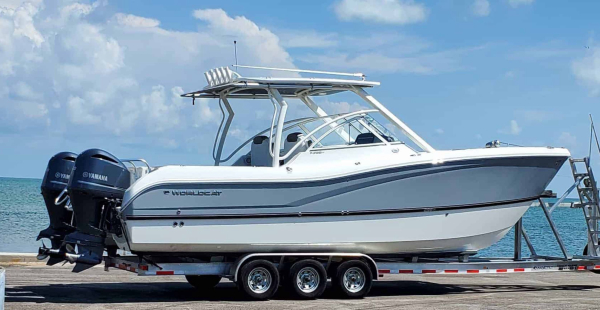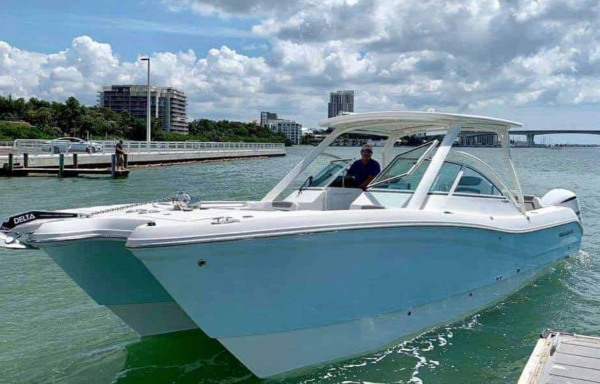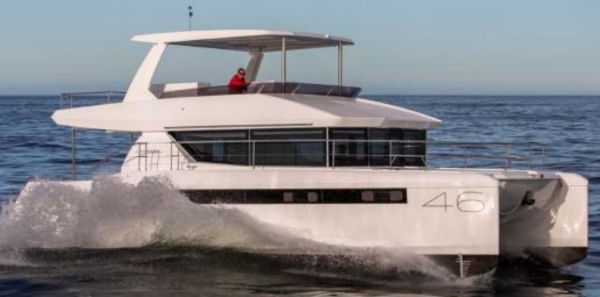By Frank Sargeant
I’m wrapping up a visit to Pensacola Beach marinas this week, and one of the impossible-to-ignore conclusions is that power catamarans are taking over the offshore fishing market.
The arrival of huge, dependable four-stroke outboards is part of the picture—charter captains here are fitting out cats from 28 to 45’ long with 1200, 1600, even 2400 horsepower in multiple outboards like the Mercury 600, and this gives them the speed to get far out into the Gulf of Mexico in about half the time a big diesel-powered sportfisher might take. This greatly lengthens their fishing day, which adds up to more satisfied customers.
Power cats ride on twin hulls, very narrow at the bow, with a tunnel between the two. The sharp forward entry splits the waves and cushions the shock, allowing them to run very fast with minimal wave impact felt inside the boat in typical sea conditions on fishing days.

Trailering large power cats takes a big trailer and a big tow vehicle, but it can be done. (World Cat)
And, while it may seem odd to consider fuel economy when we’re talking about boats with more than 1,000 horsepower, cats get very good fuel economy at displacement speeds, again because of their sharp forward entry and also because they are relatively shallow draft boats on average.
The shallow draft has a second advantage in allowing easy passage through shallow bay waters, and making it safe to slide up on a sandy beach for lunch.
Cats are also a lot wider at a given length than monohulls in most cases. A typical 40-footer will have a beam of 12 to 14 feet, and that beam is carried almost all the way to the bow, where most monohulls narrow quickly to create “the pointy end” of the boat.
In larger cruising cats like some of the Leopard models, the beam is almost half the LOA, that is a 50-footer is almost 25 feet wide. This creates a huge amount of usable interior space that’s missing on narrower monohulls of similar length.

The high twin bows of a power cat slice waves and deliver a smooth ride at speed. (World Cat)
Cats also plane more easily and at lower speeds than most monohulls, which allows them to extend their range on a given amount of fuel. On many models, you don’t feel them going “over the hump” at all—they just gradually rise up out of the water, flat, until they’re breezing along at speed.
They’re also fuel-efficient at trolling speeds, a biggie for those who tow marlin or wahoo baits all day long.
All this said, there are a few caveats.
Catamarans are heavier than monohulls of similar length, which makes them tougher to tow. You need a bigger truck and a bigger trailer, perhaps a tri-axle. And their added width may make some models illegal to tow in some states.

Large cruising type power cats have beam width nearly half their length, adding a huge amount of interior space. (Leopard Catamarans)
They also turn oddly, for those used to monohulls that lean into the turn. The feeling is sort of as if you’re sliding off a plate, because they turn almost flat. There’s a cure for this, however. Experienced cat skippers slightly increase rpm on the motor that’s on the outside of the turn before putting the helm over, and this makes the boat lean into the curve a bit.
Some models tend to “sneeze” at certain speeds in a certain height of chop as waves and air are trapped in the tunnel, creating an annoying spray over the bow. And cats are very trim sensitive—they run best when almost level, rather than a bit bow high as with most planing monohulls. Getting used to not using too much trim takes some doing, but otherwise power cats tend to “porpoise” or rock back and forth longitudinally at some speeds.
Cats often cost more than monohulls of similar length and equipment—there’s simply more fiberglass in them, so the builder wants to get that cost back.
As with all boats there are things to like and things that may not suit you just right. But if you’re in the market for a new boat, a power cat is definitely worth a test ride.